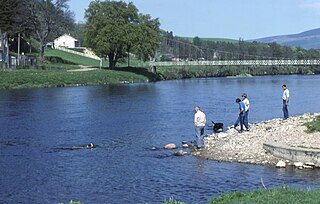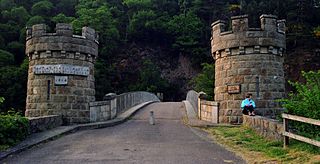 | |
| Proportion | 3:5 |
|---|---|
| Adopted | 28 October 2023 |
| Designed by | Aila Gibson |
The Moray flag is the flag of the county of Moray, registered with the Flag Institute on 28 October 2023.
 | |
| Proportion | 3:5 |
|---|---|
| Adopted | 28 October 2023 |
| Designed by | Aila Gibson |
The Moray flag is the flag of the county of Moray, registered with the Flag Institute on 28 October 2023.
On 24 January 2023 the Moray Lieutenancy announced a competition designed to secure a flag for the county. The competition launched on 27 February and ran for four weeks, alongside a similar competition in neighbouring Banffshire, with both closing on 24 March. The competition’s 626 submissions were shortlisted to four finalists by a judging panel at the end of April, for inclusion in a public vote starting 27 June and closing on 8 August. The winning design's creator, Aila Gibson of Dallas Primary School, raised the flag at an official launch ceremony on 28 October at Elgin Town Hall. The flag was raised simultaneously at Forres, Lossiemouth and Fochabers.
The Pantone colours for the flag are:
Design A

The winning design.
Design B

The central symbol is a cupola, visible atop whisky distilleries throughout Morayshire (which falls within the wider Strathspey region, known for its whisky production). The zigzag pattern references the hills surrounding the inland borders of the county. The blue stripe stands for the sky and sea, while the reddish-purple stripe is for the heather of the hills. The gold stripe symbolises Morayshire's rich agriculture, and also serves as a further homage to the county's whisky industry. [1]
Design C

The salmon stands for both Morayshire's inland waterways and the sea off its coast, as well as the county's prominent maritime fishing industry. Additionally, the salmon was revered by the Picts for its wisdom, and thus its inclusion on the flag can also serve as a symbol for the abundance of ancient sites located throughout Morayshire. [1]
Design D

The three white stars have been long associated with the Earldom of Moray (and also feature on the current arms of Moray Council). The blue is a homage to the county's heraldic traditions, albeit in a darker shade for Morayshire's dark skies. The orange stands for the whisky production of the area, with the wavy line referencing the River Spey, after which the Strathspey region is named. [1]

The national flag of France is a tricolour featuring three vertical bands coloured blue, white, and red. It is known to English speakers as the Tricolour, although the flag of Ireland and others are also known as such. The design was adopted after the French Revolution, where the revolutionaries were influenced by the horizontally striped red-white-blue flag of the Netherlands. While not the first tricolour, it became one of the most influential flags in history. The tricolour scheme was later adopted by many other nations in Europe and elsewhere, and, according to the Encyclopædia Britannica has historically stood "in symbolic opposition to the autocratic and clericalist royal standards of the past".

The flag of the state of Oregon is a two-sided flag in navy blue and gold with an optional gold fringe. On the front is the escutcheon from the state seal and on the reverse is a gold figure of a beaver, the state animal. Oregon is the only U.S. State to feature different designs on both sides of its flag.

The flag of Barbados was designed by Grantley W. Prescod and was officially adopted to represent the nation of Barbados at midnight on 30 November 1966, the day the country gained independence. The flag was chosen as part of a nationwide open contest held by the government, with Prescod's design being selected as the winner of a field of over one thousand entries. The flag is a triband design, with the outermost stripes coloured ultramarine, to represent the sea and the sky, and the middle stripe coloured gold, to represent the sand. Within the middle band is displayed the head of a trident. This trident is meant to represent the trident of Poseidon, visible in Barbados's colonial coat of arms, and the fact that it is broken is meant to represent the breaking of colonial rule in Barbados and independence from the British Empire.

The flag of Nigeria was designed by Michael Taiwo Akinkunmi and was officially adopted to represent Nigeria at midnight on 1 October 1960, the day the country gained independence. The flag was chosen as part of a nationwide open contest held by the government, with Akinkunmi's design being selected as the winner of a field of over three thousand entries. The flag is a vertical bicolour green-white-green design, with the green to represent agriculture and white to represent peace and unity.

The flag of the U.S. state of Colorado was officially adopted on June 5, 1911. The flag, designed by Andrew Carlisle Carson, consists of a fess design of three horizontal stripes of equal width, with the top and bottom stripes colored blue, and the middle stripe colored white. A circular red "C", filled with a golden disk, sits atop the stripes. All aspects of the flag contain symbolism related to the state, as the blue is meant to represent the sky, the gold the abundant sunshine the state receives, the white the snowcapped Rocky Mountains, and the red the "ruddy" earth. The gold and white portions of the flag also represent the state's gold and silver mining industries, respectively.

The state flag of Minnesota consists of a dark blue field representing the night sky and the state's shape with an eight-pointed star representing the North Star, a bright blue field representing the state's abundant waters, using a design prominently featured at the Minnesota State Capitol.

The flag of the Isle of Wight was adopted and registered in January 2009. It shows a diamond shape hovering over ocean waves. The indentation of the top corner of the diamond represents the River Medina, which is the largest river on the island.

The River Spey is a river in the northeast of Scotland. At 98 mi (158 km) it is the eighth longest river in the United Kingdom and the second longest and fastest-flowing river in Scotland. (The Tay is the longest with the Clyde third in Scotland. It is an important location for the traditions of salmon fishing and whisky production in Scotland.

In military organizations, the practice of carrying colours, standards, flags, or guidons, both to act as a rallying point for troops and to mark the location of the commander, is thought to have originated in Ancient Egypt some 5,000 years ago. The Roman Empire also made battle standards reading SPQR a part of their vast armies. It was formalized in the armies of Europe in the High Middle Ages, with standards being emblazoned with the commander's coat of arms.

The Speyside Way is a long-distance path in the Scottish Highlands. The route begins in Buckie and ends at Newtonmore,137 kilometres (85 mi) away. There is an optional spur leading off the main route to Tomintoul, adding 25 kilometres (16 mi) and 865 metres (2,838 ft) of ascent.

Craigellachie is a small village in Moray, Scotland, at the confluence of the River Spey and River Fiddich, in walking distance of the town of Aberlour.

The flag of Derbyshire is the flag of the English county of Derbyshire. Created in 2006, the flag has subsequently been registered at the Flag Institute and added to their UK Flags Register.

The Jewish Autonomous Oblast is the only Autonomous Oblast in Russia. It is situated in the Far Eastern Federal District of Russia.

Aberlour distillery is a Speyside single malt Scotch whisky distillery, in Aberlour, Strathspey, Scotland, at the confluence of the Lour Burn and River Spey near Ben Rinnes.

The Caithness flag is the flag of the county of Caithness. It was registered with the Flag Institute as the official flag of the county in 2016. The flag was unveiled by the Lord Lyon, Dr Joseph Morrow, at a ceremony in Caithness House, Wick on 26 January 2016. The Nordic cross design symbolises the ancient ties of the county to the Vikings. The black recalls the county's geology with the famous Caithness flagstone, while the gold and blue allude to the beaches and sea reinforcing the maritime nature of the county and its heritage. The traditional emblem of Caithness, a galley, is placed in the first quarter, with a raven upon its sail as it appears in the county's civic arms.

The East Lothian flag is the flag of the Scottish county of East Lothian (Haddingtonshire). It was registered with the Flag Institute on 13 December 2018 following its announcement at a reception hosted by the Lord Provost.
The flag of Earth is a concept of a possible flag design meant to symbolize the planet Earth, humankind, or a possible world government.

The Aberdeenshire flag is the flag of the traditional Scottish county of Aberdeenshire. It was registered with the Flag Institute on 22 April 2023.

The Banffshire flag is the flag of the county of Banff, registered with the Flag Institute on 28 October 2023.

The Berwickshire flag is the flag of the county of Berwick, registered with the Flag Institute in 2023.